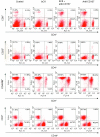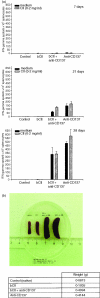Engagement of the CD137 (4-1BB) costimulatory molecule inhibits and reverses the autoimmune process in collagen-induced arthritis and establishes lasting disease resistance
- PMID: 15312139
- PMCID: PMC1782553
- DOI: 10.1111/j.1365-2567.2004.01952.x
Engagement of the CD137 (4-1BB) costimulatory molecule inhibits and reverses the autoimmune process in collagen-induced arthritis and establishes lasting disease resistance
Abstract
Agonistic antibodies against CD137 act as costimulators in the activation of CD8 T cells. They enhance the immune response against syngeneic tumour grafts and suppress T cell-dependent humoral immune responses in vivo. The present study was undertaken to determine whether suppression of antibody production by anti-CD137 mAb affects the development of collagen-induced arthritis (CIA). Male DBA/1J mice were immunized with bovine collagen II (CII) and treated with an agonistic anti-CD137 mAb or an isotype-matched control mAb. Mice were assessed regularly for macro- and microscopic signs of arthritis and for the appearance of collagen-specific antibody production. Interferon (IFN)-gamma determination, FACS analysis of splenocytes and histopathological joint examinations were performed after the animals were killed. Administration of anti-CD137 mAb at the time of collagen immunization blocked the development of disease and inhibited the humoral immune response against CII. Agonistic anti-CD137 mAb exhibited therapeutic efficacy even after the immune response to CII had succeeded and the disease became apparent. Furthermore, it induced a protective memory in the animals, enabling resistance to subsequent challenges with the pathogenic antigen. Our results suggest a key role for CD137 in the pathogenesis of CIA. This model provides insights into immunoregulatory conditions that control the pathogenesis of autoimmune diseases.
Figures







Comment in
-
CD137: costimulator turns suppressor?Immunology. 2004 Sep;113(1):23-5. doi: 10.1111/j.1365-2567.2004.01963.x. Immunology. 2004. PMID: 15312132 Free PMC article. No abstract available.
Similar articles
-
Oral administration of type-II collagen peptide 250-270 suppresses specific cellular and humoral immune response in collagen-induced arthritis.Clin Immunol. 2007 Jan;122(1):75-84. doi: 10.1016/j.clim.2006.08.004. Epub 2006 Oct 11. Clin Immunol. 2007. PMID: 17045846
-
4-1BB-mediated immunotherapy of rheumatoid arthritis.Nat Med. 2004 Oct;10(10):1088-94. doi: 10.1038/nm1107. Epub 2004 Sep 26. Nat Med. 2004. PMID: 15448685
-
Contribution of OX40/OX40 ligand interaction to the pathogenesis of rheumatoid arthritis.Eur J Immunol. 2000 Oct;30(10):2815-23. doi: 10.1002/1521-4141(200010)30:10<2815::AID-IMMU2815>3.0.CO;2-#. Eur J Immunol. 2000. PMID: 11069062
-
Immunotherapy with agonistic anti-CD137: two sides of a coin.Cell Mol Immunol. 2004 Feb;1(1):31-6. Cell Mol Immunol. 2004. PMID: 16212918 Review.
-
Immunopathogenesis of collagen arthritis.Springer Semin Immunopathol. 2003 Aug;25(1):3-18. doi: 10.1007/s00281-003-0127-1. Springer Semin Immunopathol. 2003. PMID: 12904888 Review.
Cited by
-
IFN-gamma-indoleamine-2,3 dioxygenase acts as a major suppressive factor in 4-1BB-mediated immune suppression in vivo.J Leukoc Biol. 2009 May;85(5):817-25. doi: 10.1189/jlb.0408246. Epub 2009 Feb 13. J Leukoc Biol. 2009. PMID: 19218483 Free PMC article.
-
Beyond TNF: TNF superfamily cytokines as targets for the treatment of rheumatic diseases.Nat Rev Rheumatol. 2017 Apr;13(4):217-233. doi: 10.1038/nrrheum.2017.22. Epub 2017 Mar 9. Nat Rev Rheumatol. 2017. PMID: 28275260 Free PMC article. Review.
-
CD137-mediated immunotherapy for allergic asthma.J Clin Invest. 2006 Apr;116(4):1025-36. doi: 10.1172/JCI23792. Epub 2006 Mar 9. J Clin Invest. 2006. PMID: 16528411 Free PMC article.
-
The IL-10 and IFN-gamma pathways are essential to the potent immunosuppressive activity of cultured CD8+ NKT-like cells.Genome Biol. 2008;9(7):R119. doi: 10.1186/gb-2008-9-7-r119. Epub 2008 Jul 29. Genome Biol. 2008. PMID: 18664279 Free PMC article.
-
CD137: costimulator turns suppressor?Immunology. 2004 Sep;113(1):23-5. doi: 10.1111/j.1365-2567.2004.01963.x. Immunology. 2004. PMID: 15312132 Free PMC article. No abstract available.
References
-
- Feldmann M, Brennan FM, Maini RN. Rheumatoid arthritis. Cell. 1996;85:307–10. - PubMed
-
- Myers LK, Rosloniec EF, Cremer MA, Kang AH. Collagen-induced arthritis, an animal model of autoimmunity. Life Sci. 1997;61:1861–78. - PubMed
-
- Seki N, Sudo Y, Yoshioka T, et al. Type II collagen-induced murine arthritis. I. Induction and perpetuation of arthritis require synergy between humoral and cell-mediated immunity. J Immunol. 1988;140:1477–84. - PubMed
-
- Taylor PC, Plater-Zyberk C, Maini RN. The role of the B cells in the adoptive transfer of collagen-induced arthritis from DBA/1 (H-2q) to SCID (H-2d) mice. Eur J Immunol. 1995;25:763–9. - PubMed
-
- Holmdahl R, Jansson L, Larsson A, Jonsson R. Arthritis in DBA/1 mice induced with passively transferred type II collagen immune serum. Immunohistopathology and serum levels of anti-type II collagen auto-antibodies. Scand J Immunol. 1990;31:147–57. - PubMed
Publication types
MeSH terms
Substances
LinkOut - more resources
Full Text Sources
Other Literature Sources
Medical
Research Materials
